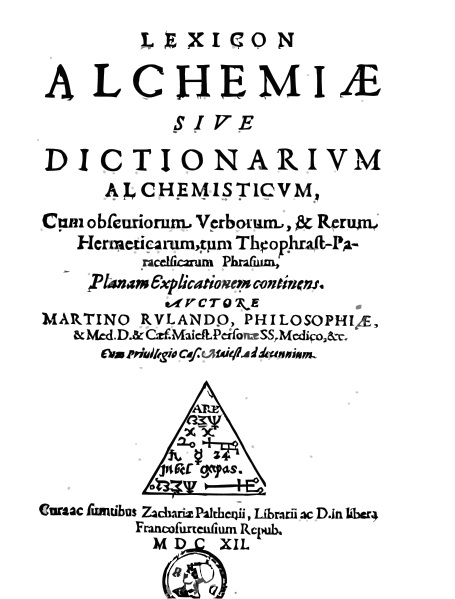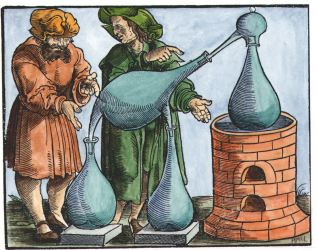| Author | Post |
|---|
Tom Willard
Member

| Joined: | Mon May 5th, 2008 |
| Location: | Tucson, Arizona USA |
| Posts: | 96 |
| Status: |
Offline
|
|
Posted: Mon Dec 28th, 2009 11:35 pm |
|
| I am curious about the sigil on the title page of the elder Martin Ruland's lexicon, of which I attach an image. Is it taken from a book by Paracelsus or another writer? Does it belong to a certain topic or concern an identifiable subject? I would be grateful for any suggestions. Attached Image (viewed 1286 times):

|
Rafal T. Prinke
Member

| Joined: | Tue Mar 4th, 2008 |
| Location: | Poland |
| Posts: | 150 |
| Status: |
Offline
|
|
Posted: Tue Dec 29th, 2009 07:53 am |
|
Hello Tom,
I found it in the pseudo-Paracelsian _Archidoxes of magic_ (tr. by Robert Turner, London 1656). Should it be helpful, I may scan the page. The "lamen" is exactly the same but of course Ruland must have taken it from the orginal the details of which I can't find now. It seems strange that such a serious lexicon has this kind of "low magic" image on the title page.
|
Tom Willard
Member

| Joined: | Mon May 5th, 2008 |
| Location: | Tucson, Arizona USA |
| Posts: | 96 |
| Status: |
Offline
|
|
Posted: Tue Dec 29th, 2009 12:31 pm |
|
Thank you, Rafal. Sudhoff includes the "Archidoxes magicae" in the volume of spuria (Part 1, Volume 14). The lamen is the first to appear and includes commentary. Presumably, Ruland did not regard the book as spurious. The text is available online from the University of Braunschweig's digital library:
http://www.digibib.tu-bs.de/view_page.php?page=477&nav=+%3C+&minpage=1&max_page=572&suffix=gif&url=http%3A%2F%2Frzbl04.biblio.etc.tu-bs.de%2Fdocportal%2Fservlets%2FMCRFileNodeServlet%2FDocPortal_derivate_00000702&offset=0Attached Image (viewed 596 times):

|
Tom Willard
Member

| Joined: | Mon May 5th, 2008 |
| Location: | Tucson, Arizona USA |
| Posts: | 96 |
| Status: |
Offline
|
|
Posted: Wed Dec 30th, 2009 03:16 am |
|
| In a summary of sigils at the end of the tract, this one is identified as useful "für die fallend Sucht" (for falling sickness, i.e., epilepsy). Paracelsus associated amulets with astrology rather than alchemy, and saw them as a way to concentrate celestial influences rather than chemical balances. He downplays them in works like Vom langen Leben, but does not discount their usefulness. Attached Image (viewed 976 times):

|
Carl Lavoie
Member
| Joined: | Wed Feb 25th, 2009 |
| Location: | Canada |
| Posts: | 215 |
| Status: |
Offline
|
|
Posted: Thu Jun 14th, 2012 06:13 am |
|
In 1849, the same year as his famous novel about The Lancashire Witches was published, William Harrison Ainsworth, as the editor of The New Monthly Magazine, printed an article on “Alchemy, Ancient and Modern” (vol. 85, April, pp. 425 – 432).
As it is one of those few unsigned contributions, I suspect Ainsworth himself to be the author.
The whole first page is a selection of quotes from the discursive fencing on the philosopher’s stone that took place between the devil and a Spanish sorcerer by the name of Elardus.
http://books.google.ca/books?id=3UAFAAAAQAAJ&lpg=PA425&ots=O3TPiMZ18f&dq=Elardus%20alchemy&pg=PA425#v=onepage&q=Elardus%20alchemy&f=false
Thorndike (VII, 159) refers to this Elardus/Ylardus and the ‘dialogue’, and gives Martin Ruland’s lesser known Progymnasmata Alchemiæ as one of the sources (Francfort, 1607, but the title page of third part where we find the dialogue is dated ‘M.DCVI.’).
http://books.google.ca/books?id=Sr923sVWH_QC&pg=PA159&dq=thorndike+magic+elardus&hl=en&sa=X&ei=oE3ZT7PXCOWJ6gGiq-XKAg&ved=0CDUQ6AEwAA#v=onepage&q&f=false
Now in Ruland, the Philosopher is actually said only to has secit quætiones ad spiritum. A case for the Cardinal Bona, I guess.
Anyway, at the end of page 84, Ylardus inquire as to the length of time needed to complete the Great Work. The answer given by the spirit is interesting as it break down a good part of the process in its various phases within the year needed (a month, then a hundred days, two more months, etc.) in a very concise manner.
http://reader.digitale-sammlungen.de/en/fs1/object/display/bsb10252974_00494.html
Quæstio. Quanto tempore potest lapis ad finem deduci?
Resp. Duodecim menses sunt necessarii, a primordio inceptionis: In triginta diebus, terra ex Saturno generatur, vel natura terræ facit creticere Saturnum. In centum diebus, crescit argentum vivum in aqua. In sexaginta diebus, completis crevit aer ex Jove. In aliis diebus anni, crescit ignis a sole. In puncto anni, anima media natura de cœlo descendit in hanc terram, et mortificat superiores & inferiores potestates. Imago multiplicis victoriæ ad consumendum bellum, in corde ventris eorum usque ad ignis judicium perpetuum. Non amplius dicam tibi.
|
Tom Willard
Member

| Joined: | Mon May 5th, 2008 |
| Location: | Tucson, Arizona USA |
| Posts: | 96 |
| Status: |
Offline
|
|
Posted: Thu Jun 14th, 2012 01:11 pm |
|
| The material appears in Manget's Bibliotheca Chemica Curiosa, appended to a tract by "Ficinus". I will post details when I return home at the end of the month. Last edited on Thu Jun 14th, 2012 01:12 pm by Tom Willard
|
Carl Lavoie
Member
| Joined: | Wed Feb 25th, 2009 |
| Location: | Canada |
| Posts: | 215 |
| Status: |
Offline
|
|
Posted: Sat Jul 7th, 2012 02:36 am |
|
.
Tom, I paste here below the reference you sent me. Thanks again.
I have it here: vol. 2, p. 183*, "Ponit Quaestiones facta à Necromantico Illardo ad Diobolum de Lapide Philosophorum."
This appears as the last chapter of a treatise "De Arte Chimica" attributed to Marsilius Ficinus.
*[Vol.II, p. 183 = p.1171/1892.]
http://alfama.sim.ucm.es/dioscorides/consulta_libro.asp?ref=X532981935&idioma=1
.
|

Current time is 09:40 am | |
|
|
|

